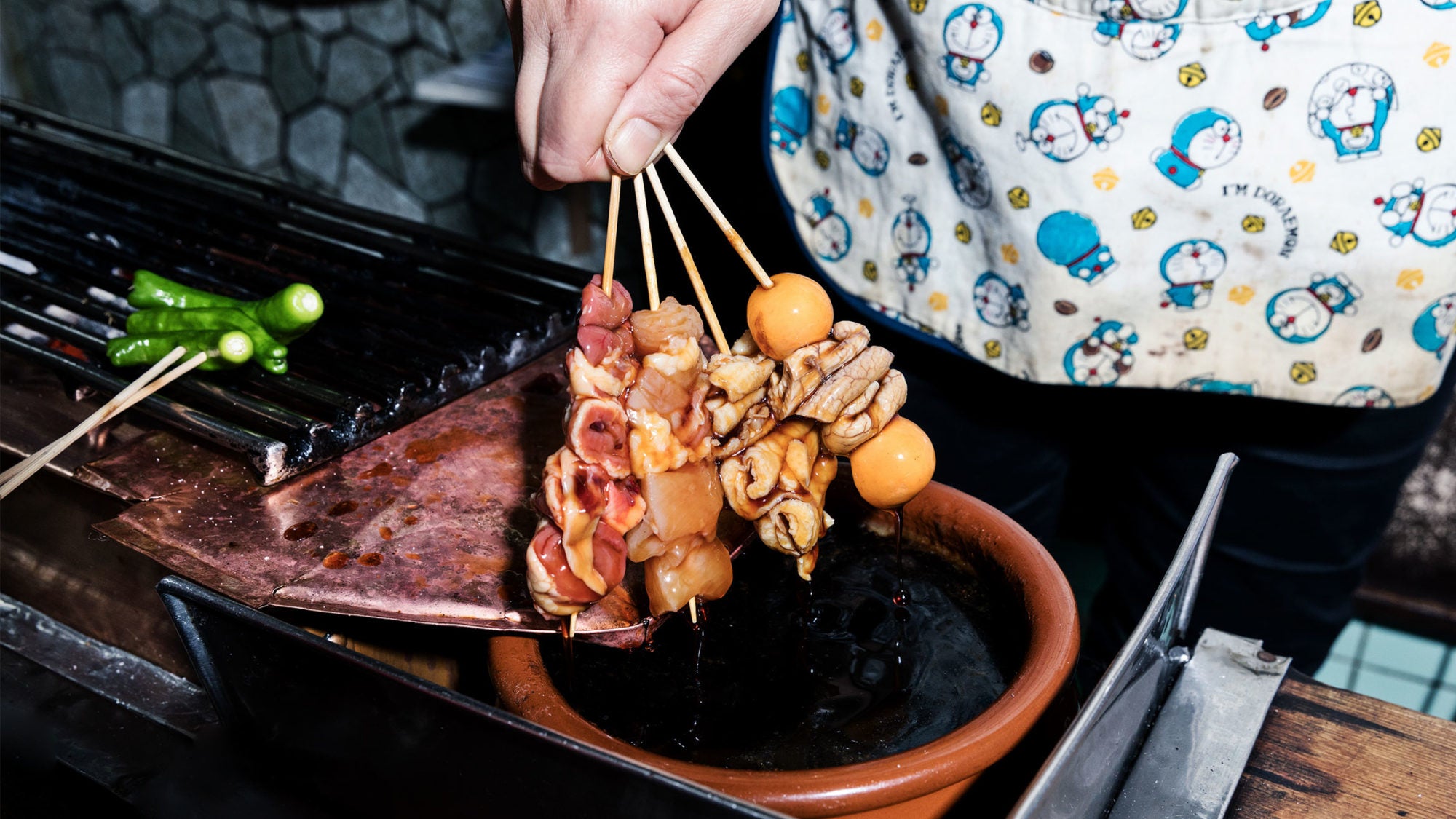
The Ito family’s heirloom sauce, traditionally used for yakitori and unagi, holds more than just umami—it holds a sweet and complicated legacy.
While nearly every country in the world has a cherished dish involving chicken, no one else reveres this feathered dinosaur with the utter respect and veneration Japan does. The chicken is a gift to this earth, and the Japanese people have masterfully unraveled all of its delicious offerings by utilizing every single part of it so that it does not die in vain. The cuisine is called yakitori—the breaking down, skewering, and grilling of chicken—seasoned with salt or tare, cooked over the scorching-hot Japanese oak charcoal known as binchotan. Unlike salt, tare (“tah-reh”), along with binchotan, has the magical ability to intensify the umami of any protein and activate all of our senses with a single bite. To be clear, tare is not a marinade but more of an accoutrement used during the grilling and finishing of a yakitori skewer, meant to accentuate but not overpower the flavor.
If you’ve ever had a genuine yakitori experience, you’ll understand just what the chicken means to the Japanese. It is more than “chicken on a stick”—it’s a sub-religion in Japan’s mecca of incredible cuisine. In Japan, there exists a spectrum of low-end to high-end yakitori establishments—from as low as $1 a skewer to $150 per person for an entire yakitori dinner course. And it is certainly never to be referred to as “teriyaki,” which is a different cooking technique in Japanese cuisine involving the basting of tare, but one that’s been incorrectly bastardized by Americans.
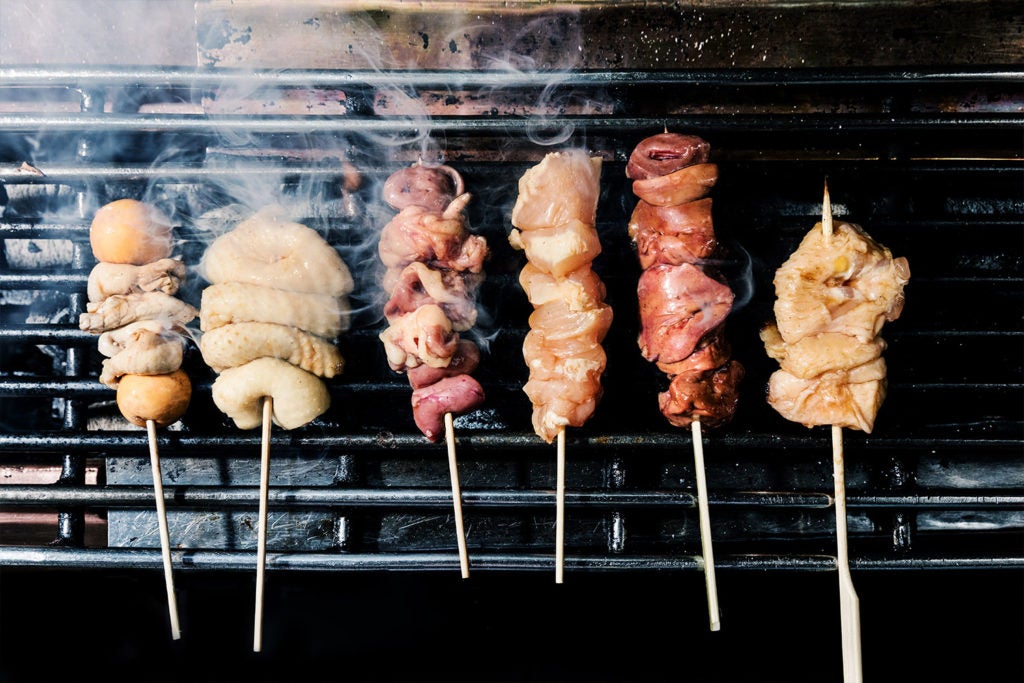
It’s been more than a decade since I fell in love with yakitori. I remember it like a first kiss, unexpected yet rewarding—maybe even more exciting, and definitely less awkward. It was after midnight in Tokyo, and I could feel all the beer and sake I had just drunk sloshing around in my stomach. I was in need of sustenance, and I slid into the most crowded yakitoriya within reach.
I sat at the counter directly in front of the yakitori taisho (literally “general,” but slang for master, chef, or boss), shielded behind a smudged glass screen, and I ordered negima, the classic Tokyo thigh-meat-and-scallion skewer served with tare. I was smitten. A piping-hot skewered piece of pillowy chicken thigh wrapped with tanned, crisp skin—cooked so impeccably over 1,000ºF, white-hot charcoal, draped in a dark, lustrous caramel-colored glaze of soy sauce, sake, mirin, and sugar. The thigh meat was so hot and juicy, I had to repeatedly exhale all the hot air to avoid scalding the inside of my mouth. The sweet, smoky tare, the fatty chicken, and the tender Japanese scallions lodged in between—it was harmony on a skewer. I professed my newfound love for yakitori over another six to seven skewers that night, setting off an obsession that would take me to almost 100 different yakitoriya throughout Japan over the next decade, eventually grilling it in my own backyard.
Yakitori might not be as world-renowned—or might not even exist—were it not for the accompaniment of tare. Tare has always been a historic and delicious component of yakitori, and it maintains prevalence in Japanese cuisine to this day. We would have to rewind more than 1,200 years to understand how this came about.
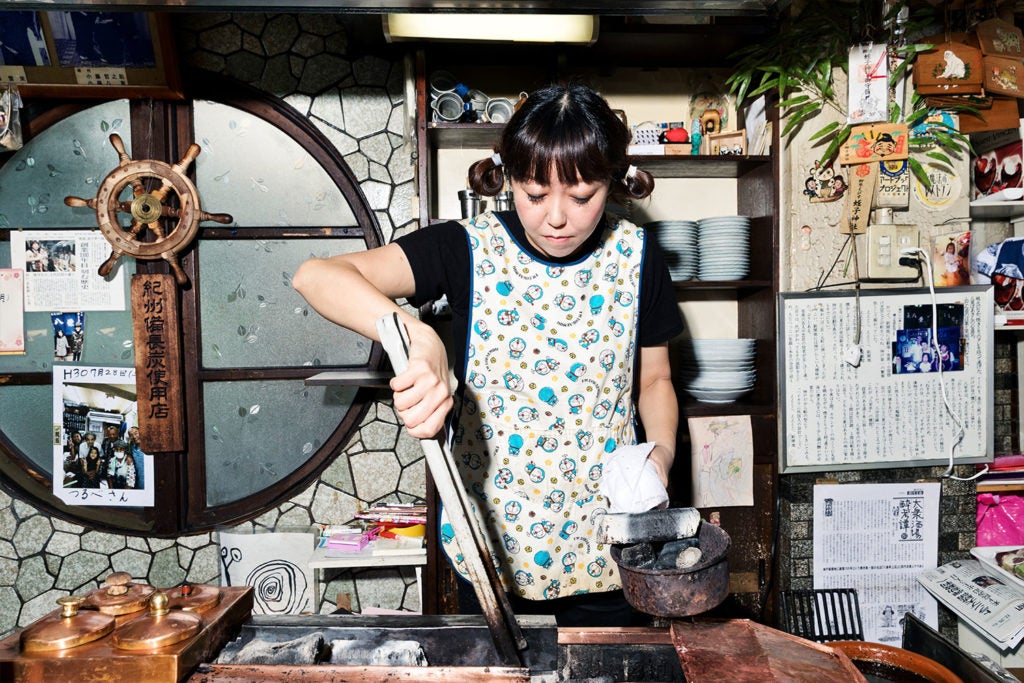
Before chicken meat was meticulously skewered on bamboo sticks for sustenance, Japan relied on an almost vegetarian diet, due to Buddhist and Shintoist practices. In the seventh century, Emperor Tenmu, a devout Buddhist, set forth a policy banning the consumption of animal meat—specifically cattle, horses, dogs, chickens, and monkeys, leading the Japanese to gradually develop aan aversion to the taste of meat, including chicken. It wasn’t until the ban on meat was lifted after the Meiji Restoration of 1868 and the increased presence of nanban jin (a term referring to Westerners such as the Portuguese and the Dutch) that the Japanese began to eat and appreciate chicken.
Yakitori stalls first appeared along the roads leading to famous shrines in various prefectures, such as the idyllic Fushimi Inari shrine in Kyoto, offering various meat skewers that could be eaten while walking, without utensils. During that time, chicken meat was expensive and reserved for royalty; many of the stalls sold game birds like duck, quail, sparrow, and thrush, along with unwanted chicken scraps and offal, such as liver, heart, soft bones, and gizzard. Grilling with salt proved to be unsuccessful for eliminating any strong aftertastes of the scraps and offal. Vendors eventually figured out that the best way to attract people who were still overcoming a distaste for meat and offal was by masking its flavor with a savory tare.
Yakitori might not be as world-renowned—or might not even exist—were it not for the accompaniment of tare.
After the tragic Kanto earthquake of 1923 and World War I, yakitori stalls rapidly increased in number, particularly in the narrow, dark alleys and the underbelly of the Tokyo black market known as yami-ichi. “Yami-ichi” refers to a clandestine, shadow economy that operated outside of the blinders of the Japanese government through World War II. Food and material goods were available, but so were other vices and illicit services involving alcohol, human trafficking, and prostitution. To ameliorate issues of poverty and hunger, yakitori vendors commonly offered their food with a heavy dousing of tare containing the artificial sweetener saccharin, which filled the stomach up for far less than the cost of sugar. Yakitori served as a means to help satiate the stomachs of the starving and impoverished, who were recovering from the aftermath of World War II.
The yakitori boom truly materialized after the war, as the United States ramped up imports of more and more broiler chickens that were initially meant to feed their troops but that eventually came to be widely consumed by the Japanese public. Broiler chickens are young chickens—just 50 to 90 days old—that are still large. They quickly became a common ingredient in Japanese cuisine because they were affordable and tender, but the taste of the meat was underdeveloped and bland. A simple slathering of tare soon changed the minds and stomachs of Japanese people and encouraged a national appreciation for grilled chicken. Today, there are an estimated 3,000 yakitori restaurants in Tokyo and more than 20,000 throughout Japan. Any of these yakitoriya provide the option of ordering your skewer with tare or shio (salt).
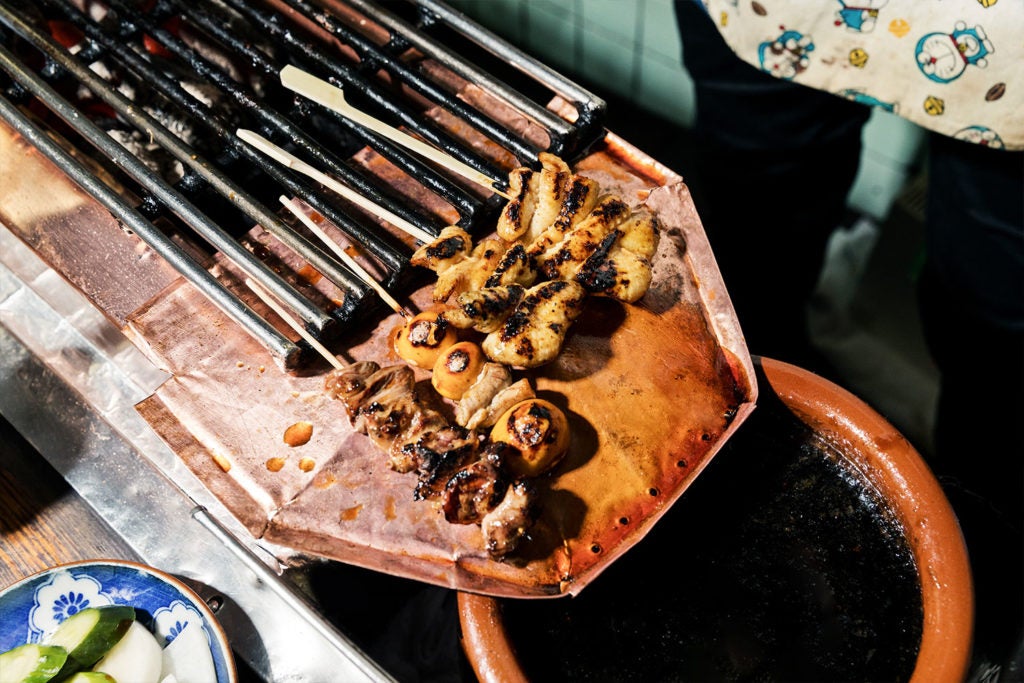
One evening last year, while going down the rabbit hole of yakitori videos online, I encountered a tiny yakitori shop in Kobe called Yaetei (ya-eh-tay) that boasted a 100-plus-year-old tare. The culinary world has long had a romance with aging and fermentation—practices that surpass the span of human lives, passed down through generations, treasured by those fortunate enough to enjoy it. This tare, though, is more than a century older than the deliciously rich and famous “Mole Madre” served at Enrique Olvera’s Pujol in Mexico City, which comprises more than 30 ingredients and is now at least six years old. But a sauce that’s more than 100 years old? This tare has lived through so much history—two world wars, the Cold War, the Vietnam War, even the Coke vs. Pepsi war! I needed to learn more about the story behind this century-old family heirloom. And I certainly needed to experience what a century-old tare tasted like for myself.
Exactly one hour’s train ride from Osaka, my wife and I found Yaetei within a few hundred meters of the station. It’s easy to miss due to its shoebox size, but upon entering through the indigo noren curtains, it’s clear the place is special. The counter, which seats no more than ten people, is within arm’s reach of the front door. The entire back wall of the grilling area is adorned with old family photos, photos of local celebrity diners, and, for some reason, a miniature wooden ship’s wheel. With the exception of sparrow and thrush, the menu has been the same for decades, with no sign of it ever changing, and consists of an aged wooden board with the names of the available skewers hand-painted on it. The ageless space feels like you’re eating in the comfort of someone’s home.
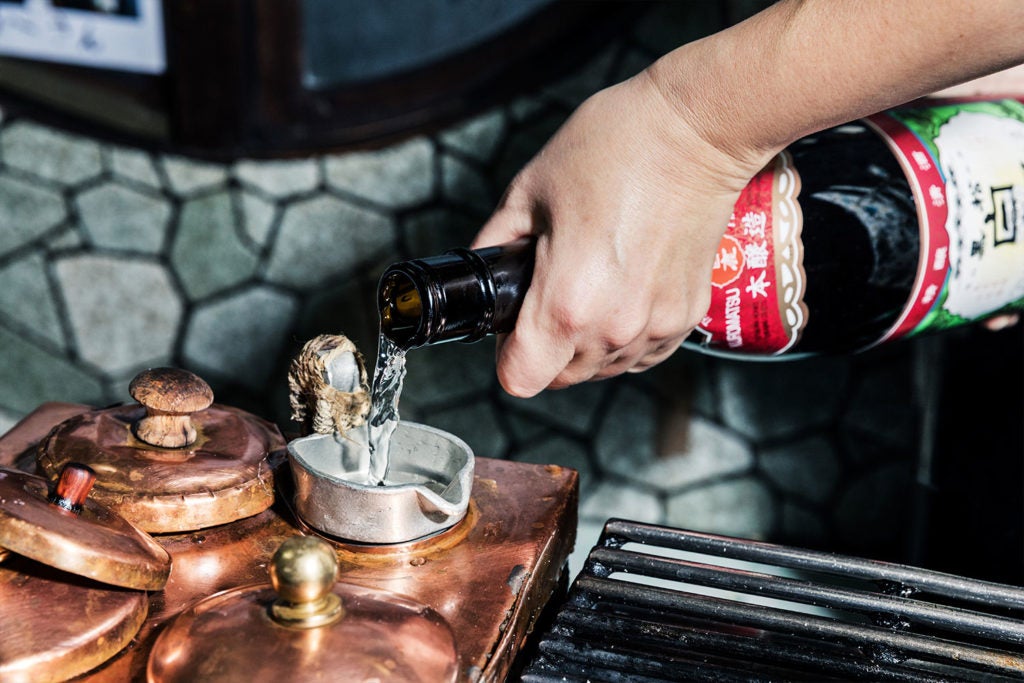
“Irasshaimase! Dozo!” says Naoko Ito, the fourth-generation owner and matriarch of the Ito family’s smoky shop, in greeting. Yaetei is named after the founder and great-grandmother of the family, Yae. Ito is at the fiery helm, wearing pigtails and an adorable Doraemon-printed apron, her face completely obscured by the billowing smoke from the grill she has inherited. She fans the smoke away, beckoning us with a smile and waving for us to have a seat directly in front of her.
“Ito-san, hajimemashite. We came all the way from Los Angeles to see you. We came to taste the 109-year-old tare.”
“Not 109—110 now!” Ito proudly corrects me.
“What would you like to eat?” she asks.
“Omakase onegaishimasu!” I reply, requesting the chef’s choice.
Ito-san has been working here since she was 16 years old. Although she stands in the same exact spot as the three generations of women before her, she never once felt obligated to be the restaurant’s successor. Raised by a strict father, she had intentions to leave Kobe. But when her mother became sick a year later, she was left with no option but to assume the matriarchal role as the grill master of Yaetei. Ito realized soon after that she was destined to take over, as she explains that “the restaurant became an extension of her,” eventually becoming the most important thing in her life.
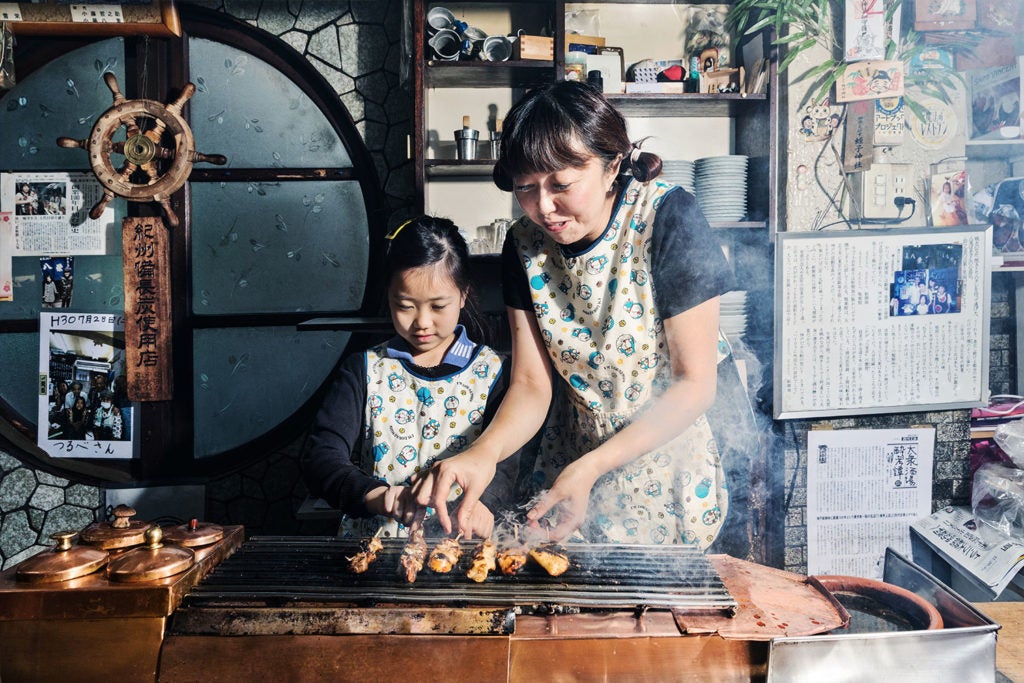
I watch as Ito-san stands proud and focused behind her classic copper-plated yakidai (grill stand). It’s the first time I’ve laid eyes on anything like this—it is the Cadillac of Japanese grills. This patinated workhorse was used by her great-grandmother and later fortified with copper plating by family members after leaks were discovered. On the left side, there’s a separate boiling chamber with four slots for chirori, small metallic sake pitchers used for warming up sake. The chirori are heated by the residual heat from the charcoal chamber, and it’s how Yaetei prefers to serve sake—warm. The grill grate extends nearly three feet into a copper resting pan made for keeping finished skewers hot. The copper pan extends over a tare tsubo, a large jar bearing exactly what we came for: the holy grail of tare.
Tare was and still is the soul of a yakitoriya, and the older the tare, the more character it develops. Though all tare share the common denominator of soy sauce, sake or mirin, and sugar, the ratio of ingredients, and the frequency and variation of skewers dipped into the tare, ultimately shape the umami and character of it. The tare builds more umami each time a skewer is dipped into the tare tsubo, picking up chicken fat and smoky binchotan ash. It is also affected by the countless number of guests that have sat at one of the ten seats and kept Yaetei in business for so long. A quiet yakitoriya is likely to have a “cold” tare. Many yakitoriya throughout Japan still use decades-old tare, but what makes Yaetei unique has everything to do with great-grandmother Yae, an attentive customer, some minor drill work, and a little physics. Ito-san tells me that during the Second World War, her great-grandmother preserved whatever tare she had in a bottle, stored it in an underground bomb shelter, and guarded it with her life, as if it were one of her children.
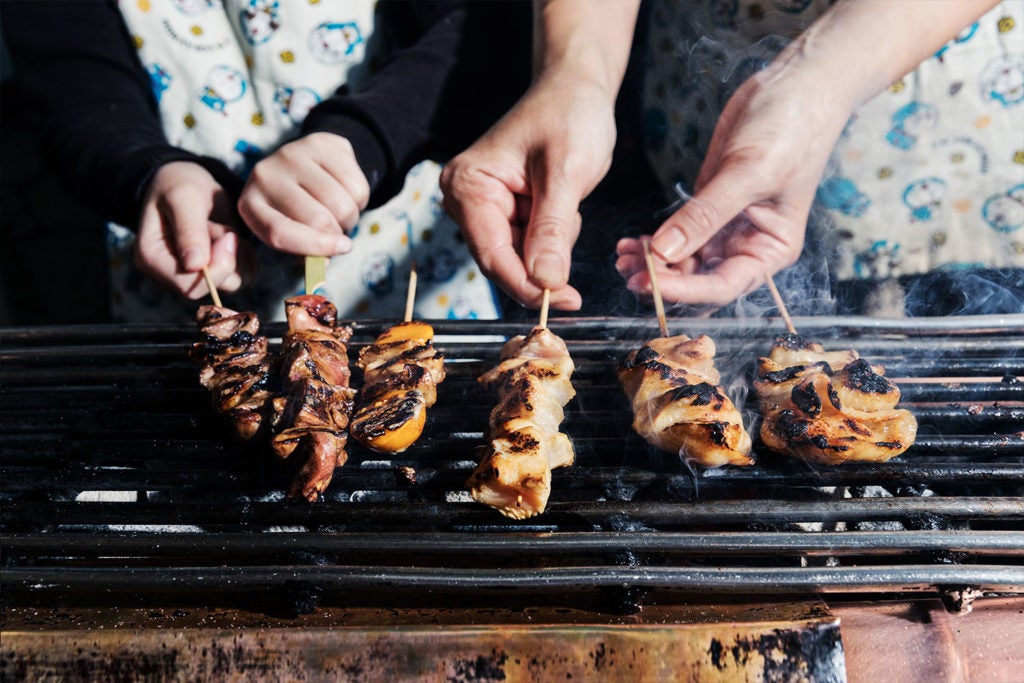
A longtime customer also noted that the grill was sloped at exactly 8 degrees, and when skewers were set on the copper pan extension, the chicken fat and tare would drip onto the pan and congeal in a pool. Yaetei took advantage of this mishap, drilling seven holes in the copper pan that allowed the runoff to intentionally drip back into the tare tsubo. A majority of yakitoriya in Japanese follow the same formula for the tare, by replenishing it with new tare once it drops down to the 80 percent level. It never generates mold, thanks to the placement of the tare tsubo near the hot yakitori grill and the ever-present layer of chicken fat sealing the surface. This has been the genius Japanese method of preserving tare for more than a century—and a means of preserving family livelihood in Japan, as it does for the Itos.
Suddenly, Ito-san is flanked by her ten-year-old daughter Hana—fresh from finishing her day’s homework—who quickly puts on a matching Doraemon apron and begins helping her mother with grillwork. For a moment, it looks like they’re playing a tag-team game of smoky foosball, and it is a sight to not only see a female chef working in a male-dominated restaurant scene in Japan, but a mother-daughter team. Yaetei is unique in that all the grill masters, past and present, have been women, and of all the yakitoriya I’ve been to, this is only the fourth time I’ve been to a woman-run shop. It’s clear Hana looks up to her mom as I catch her mirroring her mother’s grilling actions, trying to impress me and my wife.
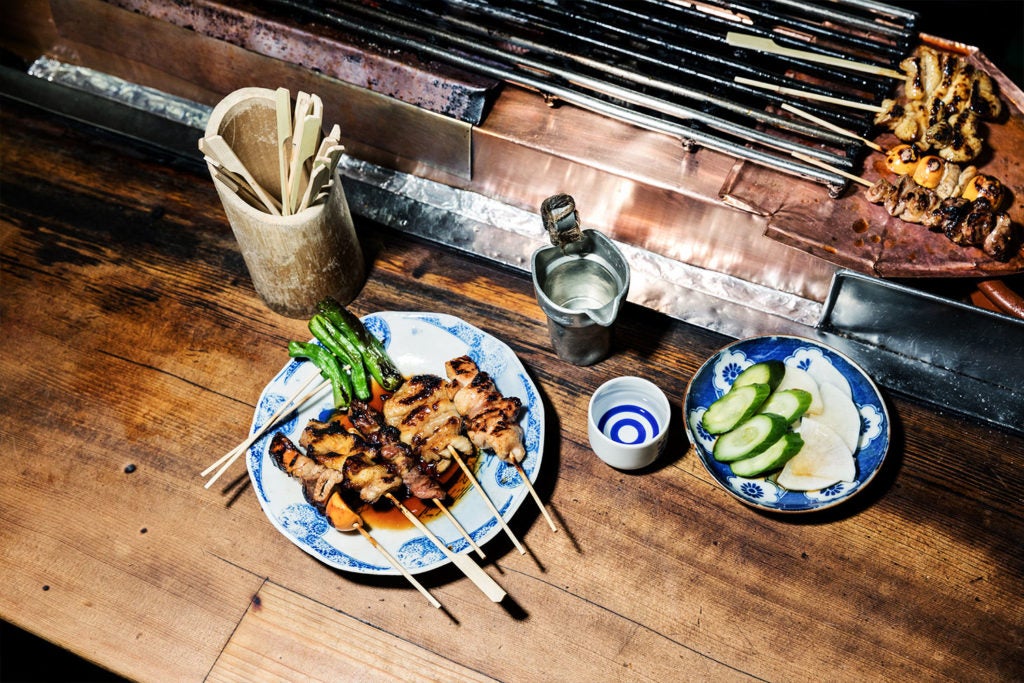
We know our order is ready once we see Ito-san dipping all five grilled skewers into the magical tare tsubo, without shaking off any excess. Our plate is absolutely covered with the beautiful, dark caramel sauce. I can’t help but bring the plate to my nose and take in all that sweet and smoky aroma. I bring it so close I get a little on my nose. I take a taste of the sauce alone with my chopsticks and note its thin but silky consistency. I seesaw the plate, watching as the shiny tare crashes into the skewer like miniature waves on a rocky shore. I see specks of black ash and carbonized chicken bits from previously dipped skewers peppering the tare. I reach for one of my favorites, the kawa skewer (chicken skin), which is slightly charred on the outside while the inside is still juicy and tender. I sink my teeth into it and savor every bit. If there’s one thing the Japanese understand in cooking, it’s balance and nodogoshi. If no one was around, I would have brought the entire plate to my face, drinking every drop of the tare like a soup—and maybe even wiping it clean with my fingers, as if it were my last meal.
“Ito-san, what’s in your tare? Soy sauce, sug—”
“Ha! Can’t tell you. It’s a family secret,” she fires back in an almost automated, polite manner.
“Is there honey?” I joke once more, knowing I’ve already lost this battle.
Ito-san shrugs and shakes her head with a smile, as we all laugh.
“Do you expect Hana to succeed you as grill master when she’s older?”
“I’m happy that she enjoys being at Yaetei. She’s aware of the legacy that precedes her, and I would like her to decide her own path in life.”
I slide the last tare-lathered piece of chicken into my mouth and discard the skewer into the kushi ire (skewer container). I hold it there on my tongue, making sure every one of my 10,000 taste buds has absorbed this centuries-old tare. As we thank Ito-san for the meal and handle the bill, I jokingly make one last effort to pry free the tare recipe—this time with Hana.
“Hana-chan, do you want to grill yakitori like your mom when you grow up?”
Hana nods.
“Do you know what’s in the tare recipe?”
Hana nods.
“Will you tell us the secret ingredients?”
“No.”
It’s obvious that Hana has already been prepped for that question, as I see her mother looking down at the grill, wearing a smirk. It’s also obvious you’ll have all the time in the world to taste this 110-year-old tare, because it’s only going to get better.
Yaetei (八栄亭 上店)
2 Chome-6-15 Shinkaichi
Hyogo Ward, Kobe, Hyogo 652-0811
Phone: +81 078-576-2474
*Note: there are two locations next to each other. Ito-san is at the “upper location” (上店), Not the “lower location” (下店).